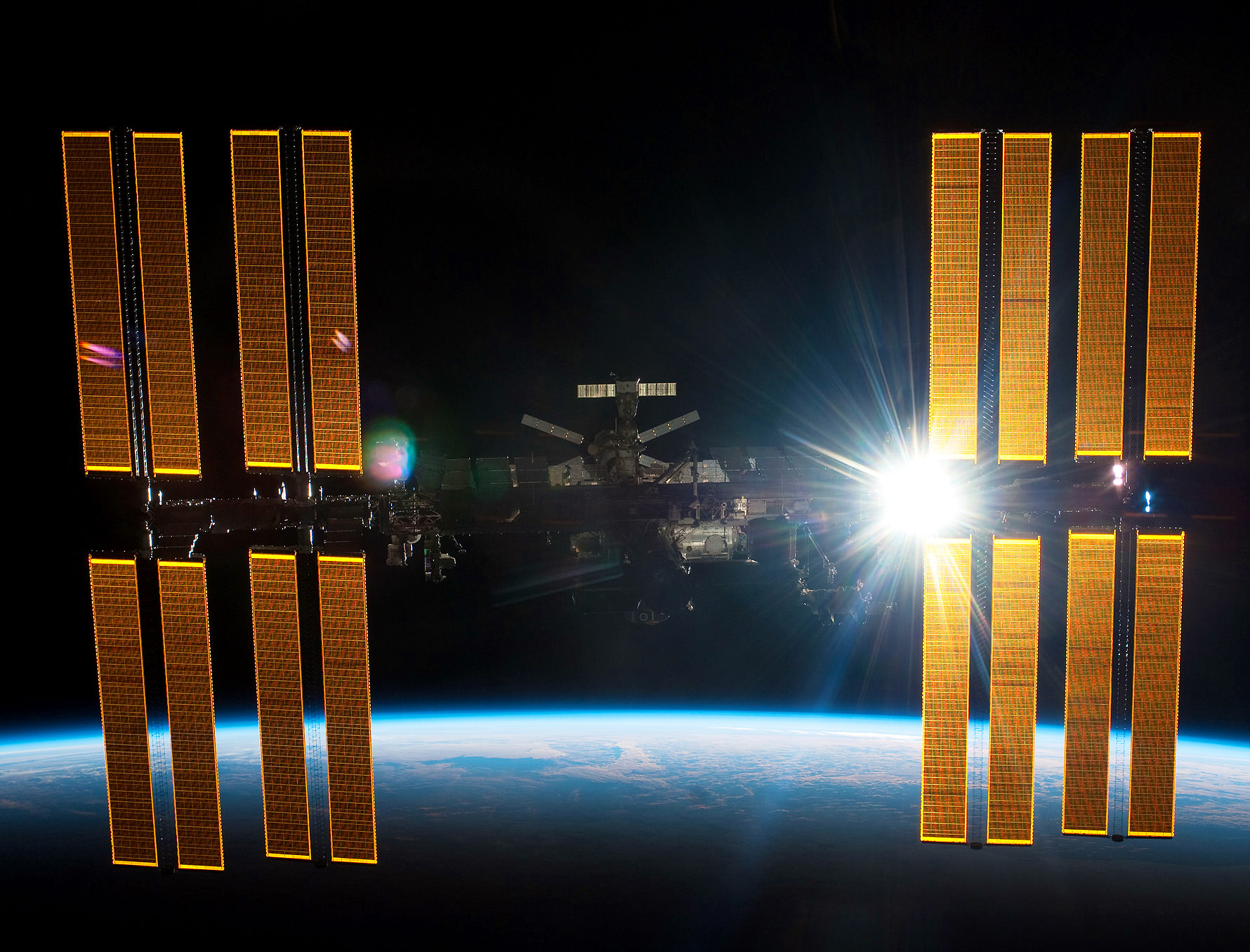No tears in heaven? Expedition 35 Commander Chris Hadfield shows that while you really can cry in space, tears don’t fall like they do here on Earth, and instead just end up as a big ball of water on your face. It’s physics, baby!
Celebrate Earth Month with 2 New Videos from NASA
Enjoy some great views of our home planet from images taken from the orbiting Earth-observing satellites and taken by astronauts on the International Space Station. The satellites and scientists are cranking out data 24/7 to help us all better understand and sustain our home planet.
Above is a video created for Earth Month, and specifically Earth Day (April 22) from ISS imagery, and below is another video from satellite imagery. These are unique looks at the beauty and wonder of our home planet.
Want to be an Astronaut? Learn How to Speak Russian
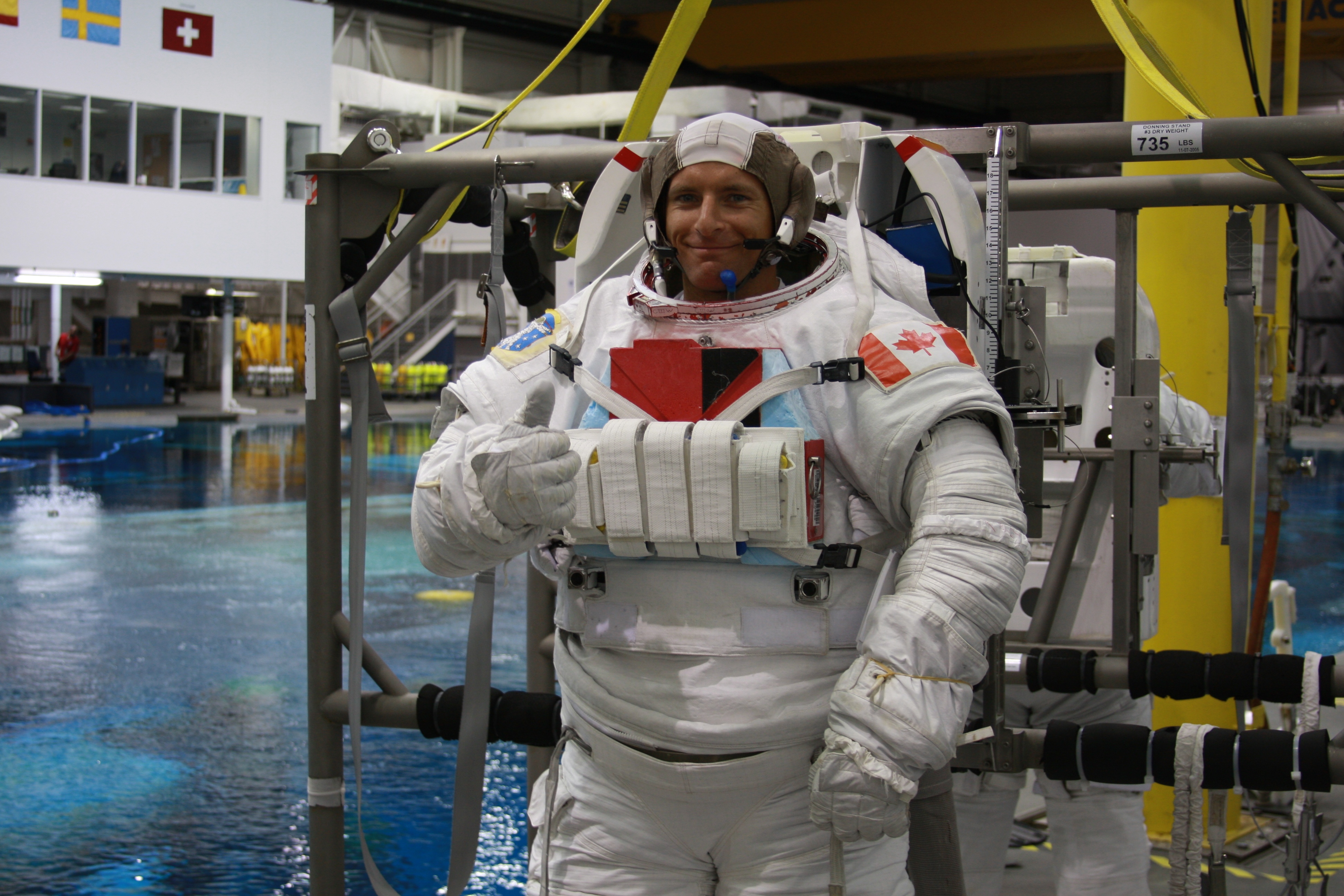
A fire breaks out on the International Space Station while the orbiting complex is over Russian mission control. How, as an English-speaking astronaut, would you keep up with instructions?
The answer is years of Russian training. In between time in simulators, jet airplanes and underwater, neophyte astronauts spend hours learning to read Cyrillic characters and pronounce consonant-heavy words. In fact, one of NASA’s requirements for its astronauts now is to learn the Russian language.
“It’s taken very seriously in the program because of the level you need to reach if, God forbid, there was an emergency on board and there was a panicky discussion going on in Russian on the radio,” Canadian astronaut and medical doctor David Saint-Jacques told Universe Today. “Ultimately, you need to be fluent to be really useful in a situation like that.”
Saint-Jacques himself is no neophyte to language learning. A native francophone, he learned English in public school and really improved it when he was 15 and moved with his family to England for a year. Today he speaks it fluently. He also has some abilities in Japanese, a language he picked up while in that country for a junior academic position at a university.
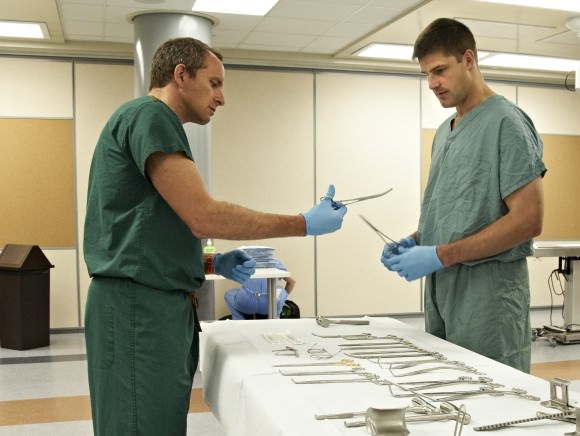
Now approaching four years as an astronaut trainee, Saint-Jacques told us how astronauts learn Russian. It’s a process that not only includes classroom instruction, but time living with a family in Moscow to really pick up on colloquialisms. Below is an edited interview.
What language training focuses on: “The point is not to write perfectly. The point is to communicate, similar to how businessmen learn languages. The emphasis for us is understanding spoken language, but the emphasis for us, the vocabulary, is different. I know all these obscure space hardware words and these crazy Russian space acronyms, but I may not know some of the flowers, for example. I can’t know everything.”
Basic Russian training: “We have Russian classes one-on-one with a Russian instructor. We get anything between one lesson every two weeks to three, four lessons a week, depending on how you accommodate the training schedule. Most astronauts want as much training as possible. It’s part of the requirements for basic training; you have to pass a certain competency test in Russian. There is a standard test that is used by the foreign affairs department, and so we do the same test. It’s a verbal test where you call the examiner on the phone and you have a discussion with them on the phone. If you pass a certain grade on that test, you are good to go.”
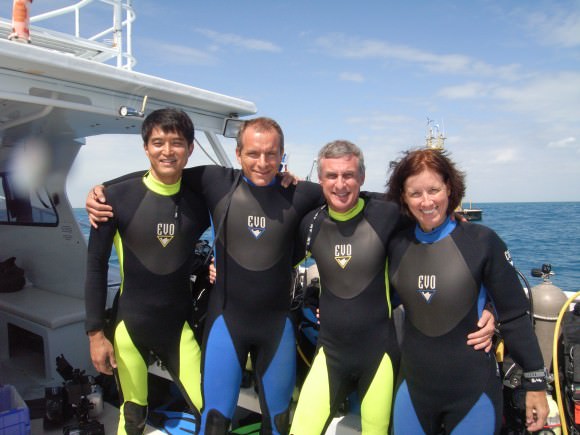
Living in Russia: “You have to go to Russia at some point to learn the Soyuz spacecraft and the Russian segment of space station. That, of course, is in all in Russian. The training is in Russian and the books are in Russian. There are translators that could be there with you, but you don’t want to rely on an interpreter for class. It really hits home; the more you know, the better. You will be living there for months, and it’s a no-brainer: you have to speak Russian when you are going to Russia.”
Immersion: “I took some holidays there [in Russia] with my family. That’s one of the great things when you speak the language of the country; you have fun there. I try to hang out with any Russian cosmonaut that comes here to Houston to keep up with them. There are two other ways we can train: you can block two to three weeks to do an intensive Russian test where all you want to do [beforehand] is study Russian. Also, when you are assigned to a spaceflight, in the year before your spaceflight, they [NASA] will try to send you for a month and a half in Moscow in a family for total immersion. That makes most people bump up their Russian level quite a lot.”
Side benefits: “It makes you realize how at the end of the day, international relations is really a form of personal relations, and speaking a language is absolutely fundamental. It makes you graduate from having a professional experience to a life experience with the other person, the other country.”
Antares Rocket Erected at Virginia Pad for Inaugural April 17 Launch – Photo Gallery
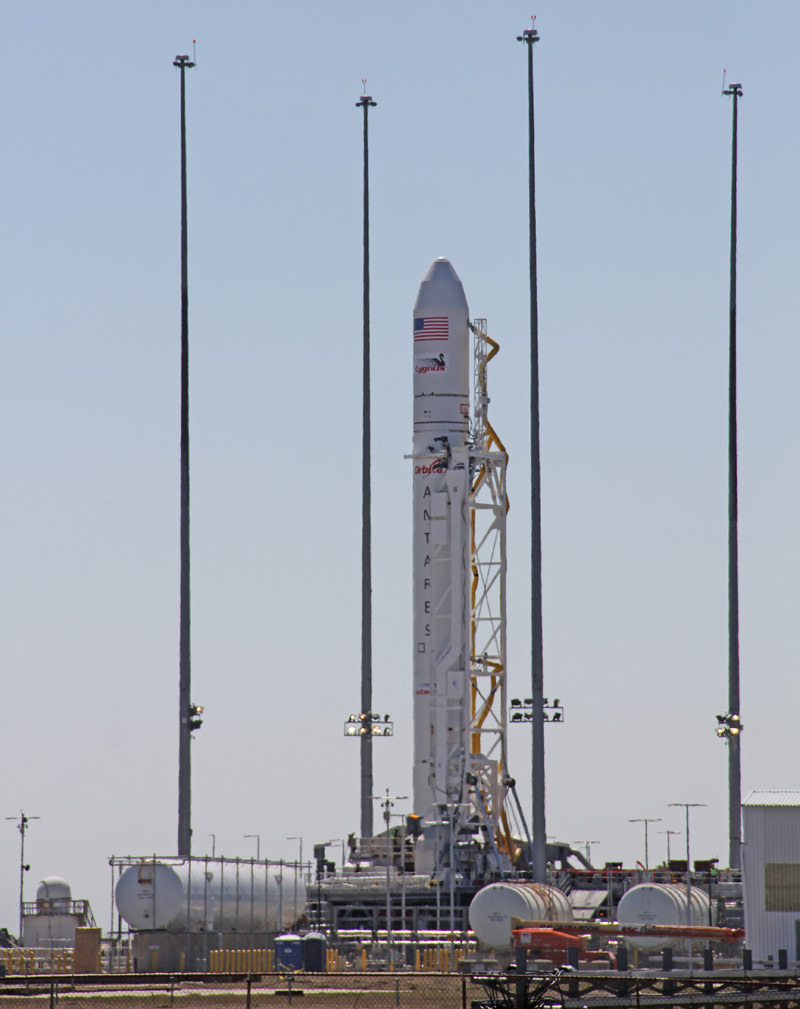
1st fully integrated Antares rocket – decaled with huge American flag – stands firmly erect at seaside Launch Pad 0-A at NASA’s Wallops Flight Facility on 6 April 2013 following night time rollout. Maiden Antares test launch is scheduled for 17 April 2013. Later operational flights are critical to resupply the ISS. Credit: Ken Kremer (kenkremer.com).
See Antares rollout and erection photo gallery below[/caption]
For the first time ever, the new and fully integrated commercial Antares rocket built by Orbital Sciences was rolled out to its oceanside launch pad on a rather chilly Saturday morning (April 6) and erected at the very edge of the Eastern Virginia shoreline in anticipation of its maiden launch slated for April 17.
The inaugural liftoff of the privately developed two stage rocket is set for 5 p.m. from the newly constructed launch pad 0-A at the Mid-Atlantic Regional Spaceport (MARS) at NASA’s Wallops Flight Facility in Virginia.
And Universe Today was there! See my photo gallery herein.
Antares is the most powerful rocket ever to ascend near major American East Coast population centers, unlike anything before. The launch is open to the public and is generating buzz.
And this is one very cool looking rocket.
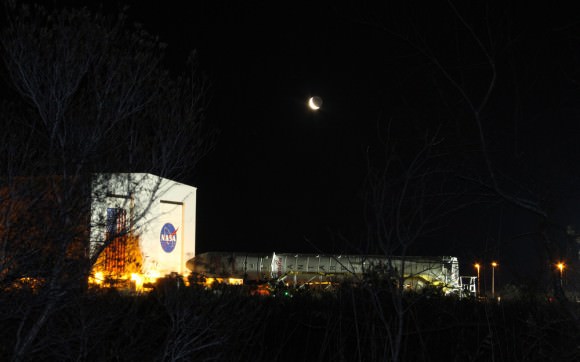
The maiden April 17 launch is actually a test flight dubbed the A-One Test Launch Mission.
The goal of the A-One mission is to validate that Antares is ready to launch Orbital‘s Cygnus capsule on a crucial docking demonstration and resupply mission to the International Space Station (ISS) as soon as this summer.
The 1 mile horizontal rollout trek of the gleaming white rocket from the NASA integration hanger to the pad on a specially designed trailer began in the dead of a frosty, windy night at 4:30 a.m. – and beneath a picturesque moon.
“We are all very happy and proud to get Antares to the pad today for the test flight,” Orbital ground operations manager Mike Brainard told Universe Today in an interview at Launch Complex 0-A.
The rocket was beautifully decaled with a huge American flag as well as the Antares, Cygnus and Orbital logos.
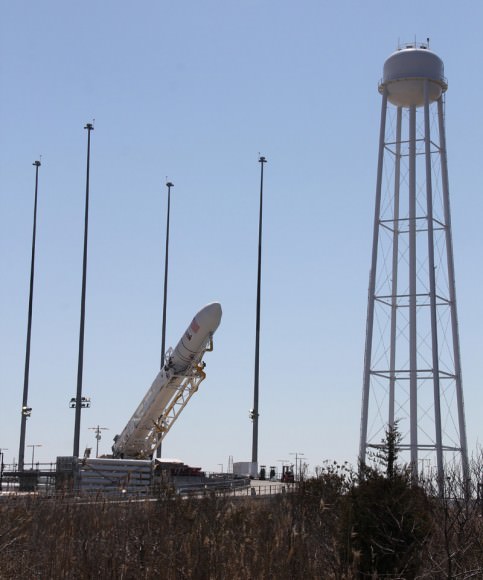
Antares was transported aboard the Transporter/Erector/Launcher (TEL), a multifunctional, specialized vehicle that also slowly raised the rocket to a vertical position on the launch pad a few hours later, starting at about 1 p.m. under clear blue skies.
This first ever Antares erection took about 30 minutes. The lift was postponed for several hours after arriving at the pad as Orbital personal monitored the continually gusting winds approaching the 29 knot limit and checked all pad and rocket systems to insure safety.
The TEL vehicle also serves as a support interface between the 133-foot Antares and the range of launch complex systems.
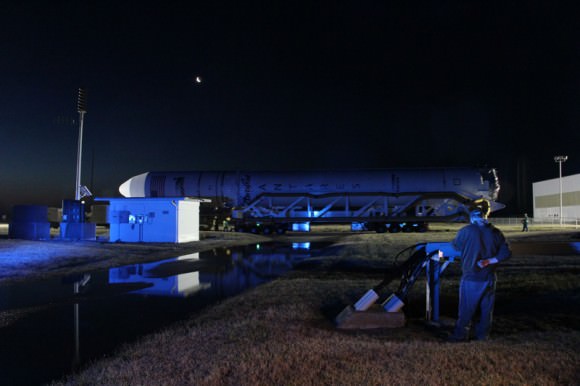
Now that Antares stands vertical, “We are on a clear path to a launch date of April 17, provided there are no significant weather disruptions or major vehicle check-out delays between now and then,” said Mr. Michael Pinkston, Orbitals Antares Program Manager.
Antares is a medium class rocket similar to the Delta II and SpaceX Falcon 9.
For this test flight Antares will boost a simulated version of the Cygnus carrier – known as a mass simulator – into a target orbit of 250 x 300 kilometers and inclined 51.6 degrees.
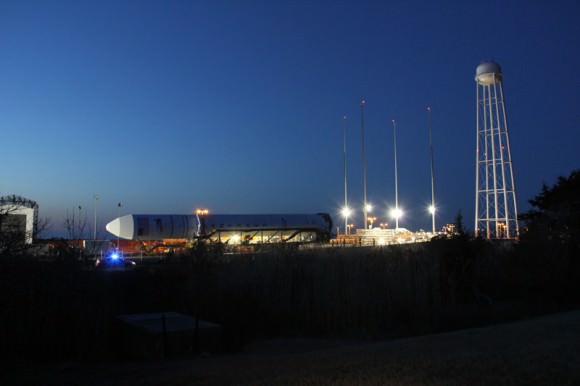
The Antares first stage is powered by dual liquid fueled AJ26 first stage rocket engines that generate a combined total thrust of some 680,000 lbs. The upper stage features a Castor 30 solid rocket motor with thrust vectoring. Antares can loft payloads weighing over 5000 kg to LEO.
The Antares/Cygnus system was developed by Orbital Sciences Corp under NASA’s Commercial Orbital Transportation Services (COTS) program to replace the ISS cargo resupply capability previously tasked to NASA’s now retired Space Shuttle fleet.
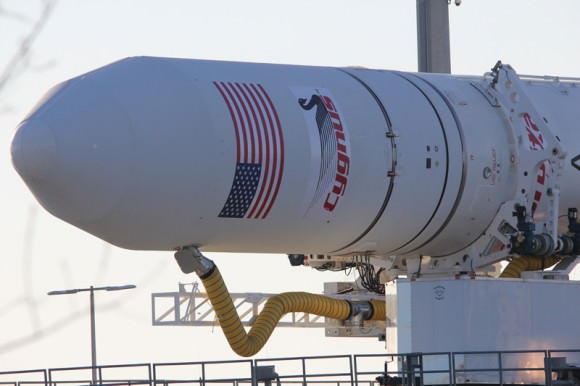
Orbital’s Antares/Cygnus system is similar in scope to the SpaceX Falcon 9/Dragon system. Both firms won lucrative NASA contracts to deliver approximately 20,000 kilograms of supplies and equipment to the ISS.
The goal of NASA’s COTS initiative is to achieve safe, reliable and cost-effective transportation to and from the ISS and low-Earth orbit (LEO).
Orbital will launch at least eight Antares/Cygnus resupply missions to the ISS at a cost of $1.9 Billion
The maiden Antares launch has been postponed by about 2 years due to delays in laiunch pad construction and validating the rocket and engines for flight- similar in length to the start up delays experienced by SpaceX for Falcon 9 and Dragon.
Read my prior Antares story detailing my tour of the launch complex following the successful 29 sec hot-fire engine test that cleared the path for the April 17 liftoff – here & here.
Watch for my continuing reports through liftoff of the Antares A-One Test flight.
…………….
Learn more about Antares, SpaceX, Curiosity and NASA missions at Ken’s upcoming lecture presentations:
April 20/21 : “Curiosity and the Search for Life on Mars – (in 3-D)”. Plus Orion, SpaceX, Antares, the Space Shuttle and more! NEAF Astronomy Forum, Suffern, NY
April 28: “Curiosity and the Search for Life on Mars – (in 3-D)”. Plus the Space Shuttle, SpaceX, Antares, Orion and more. Washington Crossing State Park, Titusville, NJ, 130 PM

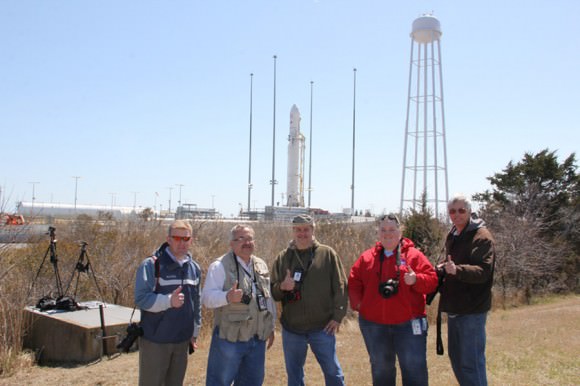
How Do Astronauts on the Space Station Stay in Touch with Earth?
Gemini 8 was in trouble. The spacecraft was spinning rapidly, the astronauts were fighting to stay conscious, and worst of all — they were out of the reach of NASA’s Mission Control.
The astronauts eventually did make contact during that 1966 mission, and splashed down safely. Still, the incident illustrated a weakness of having scattered ground stations staying in touch with orbiting spacecraft. NASA had a large network of stations, including ships and remote satellite dishes, but there were large gaps in coverage.
Today, NASA and Roscosmos (the Russian space agency) have virtually 100% communications contact with orbiting astronauts and cosmonauts in the International Space Station, including video. That’s due to a network of satellites called the Tracking and Data Relay Satellite system. The first of these satellites launched 30 years ago today (April 5) in 1983.
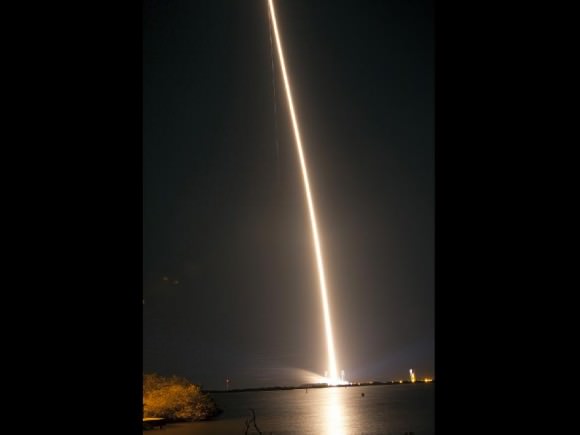
TDRS includes seven operational satellites that are in geosynchronous orbit (essentially, in an orbit that keeps them above a fixed location on Earth.) The satellites are designed to serve spacecraft that are orbiting in low Earth orbit, above 45 miles (73 kilometers) in altitude. They’re spaced out to make sure that customers receive coverage throughout the orbit. Operations on the ground consist of two ground terminals located near Las Cruces, New Mexico.
Launching these satellites took years. Although the first satellite was deployed successfully, the second one was destroyed in the Challenger shuttle explosion of 1986. The rest of the first generation of TDRS satellites went into space between 1988 and 1995. Three more advanced satellites then launched between 2000 and 2002.
This means the TDRS fleet is getting pretty old, but luckily, there are fresh replacements on the way. TDRS-K launched in January and is still being tested before assuming operational status. TDRS-L will launch in 2014, and TDRS-M in 2015.
How the Air Force and SpaceX Saved Dragon from Doom
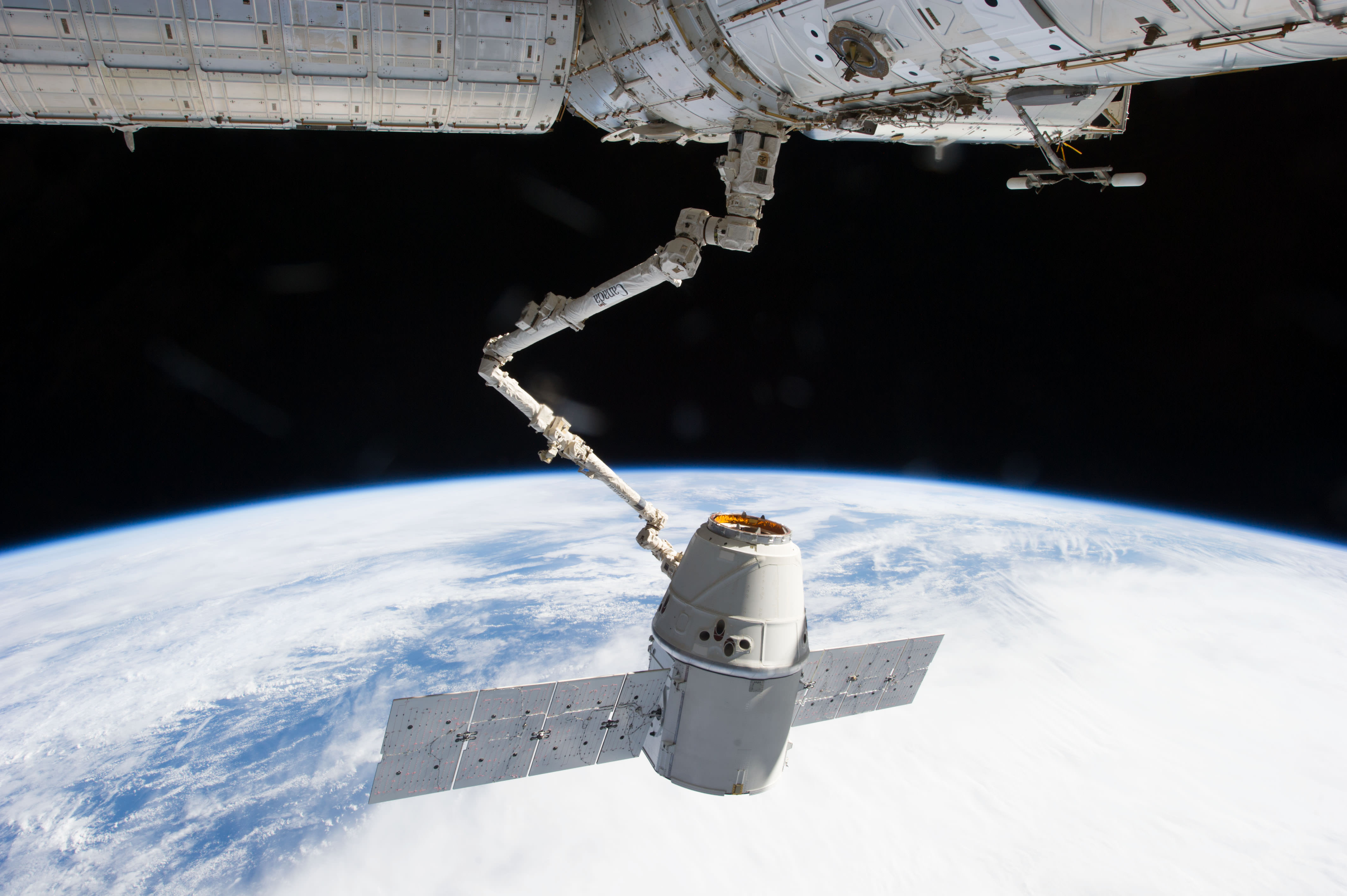
The picture perfect docking of the SpaceX Dragon capsule to the International Space Station (ISS) on March 3 and the triumphant ocean splashdown last week on March 26 nearly weren’t to be – and it all goes back to a microscopic manufacturing mistake in the oxidizer tank check valves that no one noticed long before the vessel ever took flight.
Barely 11 minutes after I witnessed the spectacular March 1 blastoff of the Dragon atop the SpaceX Falcon 9 rocket from Cape Canaveral, Florida, everyone’s glee suddenly turned to disbelief and gloom with the alarming news from SpaceX Mission Control that contact had been lost.
I asked SpaceX CEO and founder Elon Musk to explain what caused the failure and how they saved the drifting, uncontrolled Dragon capsule from doom – just in the nick of time.
Applying the space version of the Heimlich maneuver turned out to be the key. But if you can’t talk to the patient – all is lost.
 Right after spacecraft separation in low Earth orbit , a sudden and unexpected failure of the Dragon’s critical thrust pods had prevented three out of four from initializing and firing. The oxidizer pressure was low in three tanks. And the propulsion system is required to orient the craft for two way communication and to propel the Dragon to the orbiting lab complex.
Right after spacecraft separation in low Earth orbit , a sudden and unexpected failure of the Dragon’s critical thrust pods had prevented three out of four from initializing and firing. The oxidizer pressure was low in three tanks. And the propulsion system is required to orient the craft for two way communication and to propel the Dragon to the orbiting lab complex.
So at first the outlook for the $133 million Dragon CRS-2 cargo resupply mission to the ISS appeared dire.
Then, SpaceX engineers and the U.S Air Force sprang into action and staged an amazing turnaround.
“The problem was a very tiny change to the check valves that serve the oxidizer tanks on Dragon.” Musk told Universe Today
“Three of the check valves were actually different from the prior check valves that had flown – in a very tiny way. Because of the tiny change they got stuck.”
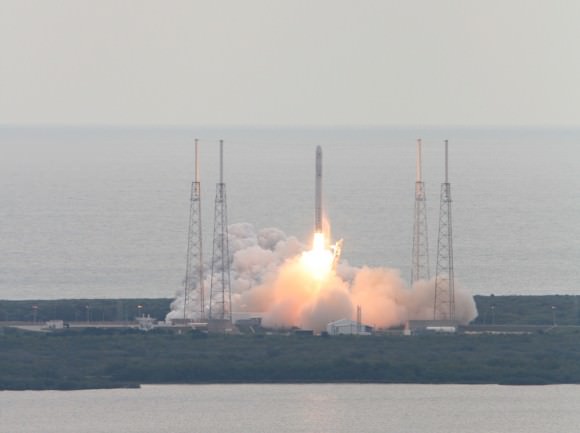
SpaceX engineers worked frantically to troubleshoot the thruster issues in an urgent bid to overcome the serious glitch and bring the crucial propulsion systems back on line.
“What we did was we were able to write some new software in real time and upload that to Dragon to build pressure upstream of the check valves and then released that pressure- to give it a kind of a kick,” Musk told me at a NASA media briefing.
“For the spacecraft you could call it kind of a Heimlich maneuver. Basically that got the valves unstuck and then they worked well”
“But we had difficulty communicating with the spacecraft because it was in free drift in orbit.”
“So we worked closely with the Air Force to get higher intensity, more powerful dishes to communicate with the spacecraft and upload the software to do the Heimlich pressure maneuver.”
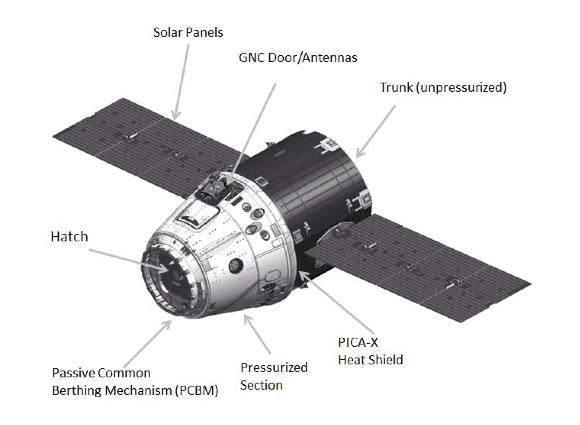
Just how concerned was Musk?
“Yes, definitely it was a worrying time,” Musk elaborated.
“It was a little frightening,” Musk had said right after the March 1 launch.
Later in the briefing Musk explained that there had been a small design change to the check valves by the supplier.
“The supplier had made mistakes that we didn’t catch,” said Musk. “You would need a magnifying glass to see the difference.”
SpaceX had run the new check valves through a series of low pressurization systems tests and they worked well and didn’t get stuck. But SpaceX had failed to run the functional tests at higher pressures.
“We’ll make sure we don’t repeat that error in the future,” Musk stated.
Musk added that SpaceX will revert to the old check valves and run tests to make sure this failure doesn’t happen again.
SpaceX, along with Orbital Sciences Corp, are both partnered with NASA’s Commercial Resupply Services program to replace the cargo up mass capability the US lost following the retirement of NASA’s space shuttle orbiters in 2011.
Orbital’s Antares rocket could blast off on its first test mission as early as April 17.
Of course the Dragon CRS-2 flight isn’t the first inflight space emergency, and surely won’t be the last either.
So, for some additional perspective on the history of reacting to unexpected emergencies in space on both human spaceflight and robotic science probes, Universe Today contacted noted space historian Roger Launius, of the Smithsonian National Air & Space Museum (NASM).
Roger provided these insights to Universe Today editor Nancy Atkinson – included here:
“There are many instances in the history of spaceflight in which the mission had difficulties that were overcome and it proved successful,” said Launius.
“Let’s start with Hubble Space Telescope which had a spherical aberration on its mirror and the first reports in 1990 were that it would be a total loss, but the engineers found workarounds that allowed it to be successful even before the December 1993 servicing mission by a shuttle crew that really turned it into a superb scientific instrument.”
“Then what about Galileo, the Jupiter probe, which had a problem with its high gain antenna. It never did fully deploy but the engineers found ways to overcome that problem with the communication system and the spacecraft turned into a stunning success.”
“If you want to feature human spaceflight let’s start with the 1999 shuttle flight with Eileen Collins as commander that had a shutdown of the SSMEs prematurely and it failed to reach its optimum orbit. It still completed virtually all of the mission requirements.”
“That says nothing about Apollo 13,… I could go on and on. In virtually every mission there has been something potentially damaging to the mission that has happened. Mostly the folks working the mission have planned for contingencies and implement them and the public rarely hears about it as it looks from the outside like a flawless operation.”
“Bottom line, the recovery of the Dragon capsule was not all that amazing. It was engineers in the space business doing what they do best,” said Launius.
…………….
Learn more about SpaceX, Antares, Curiosity and NASA missions at Ken’s upcoming lecture presentations:
April 20/21 : “Curiosity and the Search for Life on Mars – (in 3-D)”. Plus Orion, SpaceX, Antares, the Space Shuttle and more! NEAF Astronomy Forum, Suffern, NY
April 28: “Curiosity and the Search for Life on Mars – (in 3-D)”. Plus the Space Shuttle, SpaceX, Antares, Orion and more. Washington Crossing State Park, Titusville, NJ, 130 PM
SpaceX Falcon 9 rocket and Dragon capsule poised to blast off from Cape Canaveral Air Force Station, Florida on a commercial resupply mission to the ISS. Credit: Ken Kremer/www.kenkremer.comBuilding the Alpha Magnetic Spectrometer: 16 Years in 3 Minutes
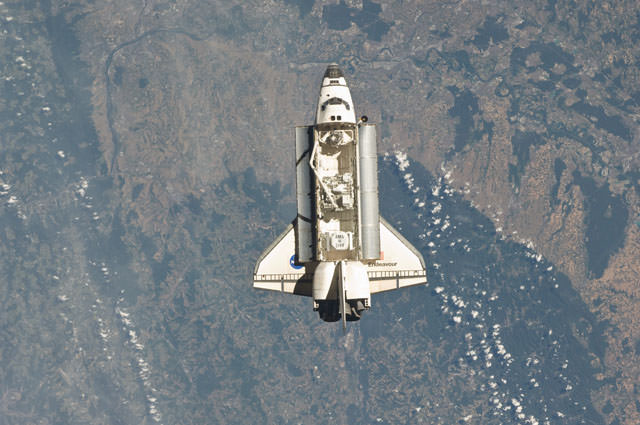
The Alpha Magnetic Spectrometer on board the International Space Station released its first results today (read about them here) after having been in space since 2011. But this particle physics experiment was years in the making. In just 3 minutes, you can watch 16 years of building, preparing, launching and activating this detector.
Below, watch another video from NASA that provides an overview of the AMS:
Astronaut Photos Create a Map of the World
If you could spend a few months — or even a few days — living aboard the ISS, what would you take pictures of? Earth, most likely, with your favorite landforms and your family’s and friends’ hometowns ranking high on the list. After a while, I’m sure plenty of other Earthly features would become photo targets — weather, aurorae, world cities at night, etc. — but ultimately, over the course of your stay in orbit, you would be able to see a trend in the pictures you take, and where you took them.
And over the span of 35 missions across more than 12 years, the graph above shows the trend of all the astronauts’ pictures. Look familiar?

Created by open-source NASA data aficionado Nate Bergey, the image above is a map made up of over a million points (1,129,177, to be exact) each representing the global coordinates of an JSC-archived photograph taken from the ISS.
Clearly the continents are astronauts’ favored photo subjects, with the populous urban areas of North America, Europe, Egypt and the Middle East, as well as the western and southern coasts of South America standing out.
“This makes sense, photos of clouds over an otherwise blank ocean get old after a while,” Nate Bergey wrote on his blog, open.nasa.gov. “I’m sure every astronaut has taken at least one photograph of the town they grew up in.”
Of course, the map doesn’t create an image of the entire globe. This is because the points denote actual over-ground coordinates of the Station (not necessarily what the photos themselves are of) and “the ISS stays between about 50° and -50° latitude as it orbits the Earth,” as noted by Bergey.
A map of the world with the points overlaid onto it, color-coded by mission, shows the difference:
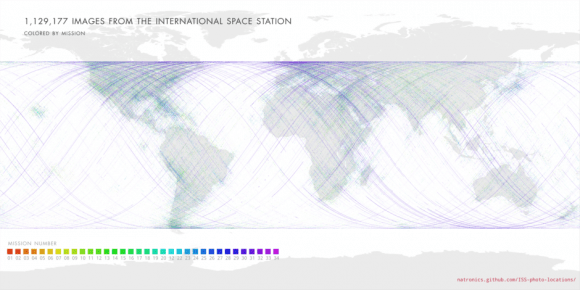
Bergey also notes the proliferation of purple-colored dots… these indicate the hundreds of images taken by NASA astronaut Don Pettit during Expedition 30/31, when he created incredible time-lapse videos of the Earth from the ISS.
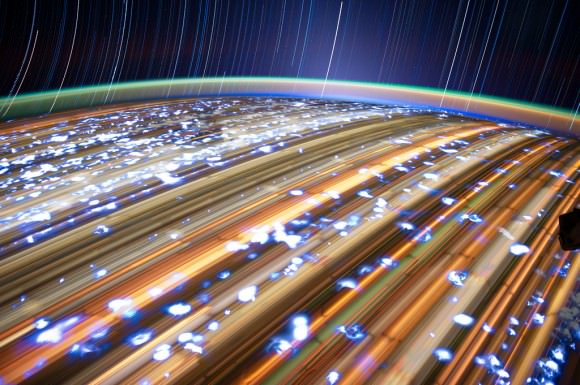
With such a unique and lofty perspective of our world, it’s no wonder that astronauts spend so much time snapping photos — I can’t say I’d be able to tear myself away from the window myself! Read more about Nate Bergey’s project and how he created his map on his open.NASA blog here.
Happy Easter Sunday from the ISS ! Crew Hunts Easter Eggs & Goodies
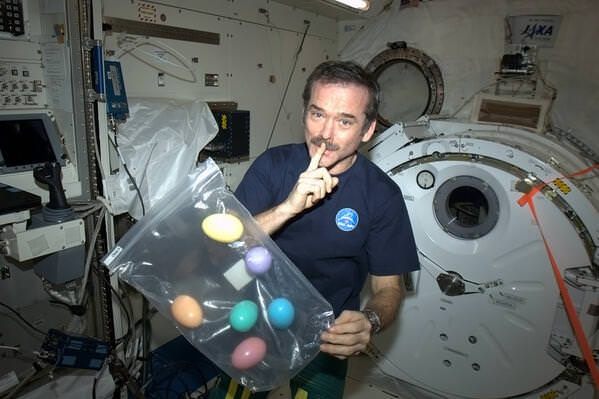
ISS Commander Chris Hadfield plans surprise Easter egg hunt for station crew today – Easter Sunday, March 31, 2013. Credit: NASA/Chris Hadfield
Updated with more astounding ‘Easter from Space’ photos by Chris Hadfield !
Dont miss the scrumptious ‘Easter Finale’ – below
Thank you Chris ![/caption]
Hush, hush !
Don’t’ tell his crew, but Canadian astronaut Chris Hadfield has secretly planned a delightful space station surprise sure to also warm the hearts of Earth’s children celebrating the joyous occasion of this Easter Sunday – and there’s delicious photos below too.
They’re going on an Easter egg hunt !
“Don’t tell my crew, but I brought them Easter Eggs :)”, tweeted Hadfield from the ISS – where he currently serves as Commander of the Expedition 35 crew.
And Hadfield sends his greetings and ‘Easter from Space’ photos to all of us down here on the good Earth on this Holy Day.
“Good Morning, Earth! A fine Easter Sunday morning to you, from the crew of the International Space Station.”
You can follow along with Hadfield’s adventures from space as – @Cmdr_Hadfield
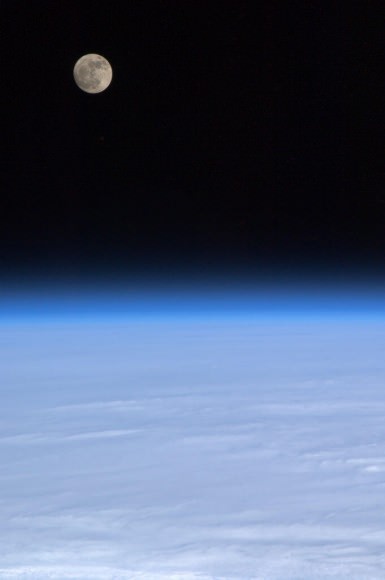
Occasionally, Mission Control relents and lets the astronauts have fun, taking a break from their out of this world chores.
But given the weightless of space, it’s not obvious how they’ll accomplish the traditional Easter egg roll. Perhaps we’ll hear about that later.
And there’s no word back yet on Easter Bunny sightings.
Well, to get ready Hadfield has been busy stashing assorted Easter goodies & gifts in the gazillion nooks and crannies aboard the ISS – and snapping fun photos for all the kids to play along.
“Sometimes the best place to hide an item is floating right above your nose. Or in this case, your sleep pod.”
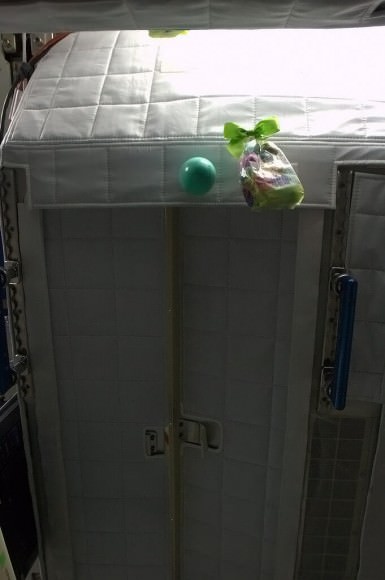
Hadfield just couldn’t resist the temptation of some weightless juggling – and he’s not telling if they went .. splat !!
“It appears that I’m as bad at juggling in weightlessness as I am on Earth. Hopefully I’m better at hiding them… ”
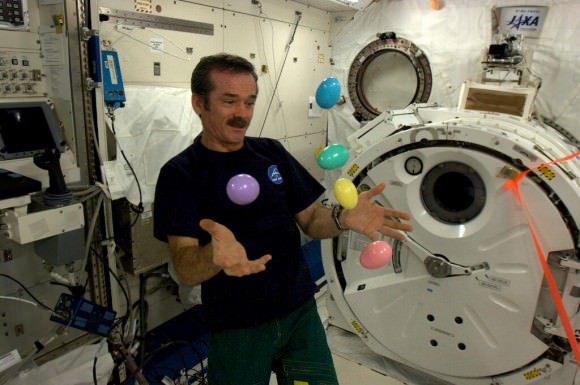
Time will tell whether the crew of six guys are indeed clever enough to figure out all the secret hiding spots.
The Easter egg hunt could be especially trying for the three ‘new guys’ who just arrived on Thursday, March 28, on the Russian Soyuz express capsule – comprising of Russian cosmonauts Pavel Vinogradov and Alexander Misurkin and NASA astronaut Chris Cassidy. They join Hadfield, astronaut Tom Marshburn and cosmonaut Roman Romanenko who will stay aboard the station until May.
In the meantime, Hadfield is playfully diverting everyone’s concentration with gorgeous shots of Earth, like the Easter sunrise glinting across North America’s heartland – below.
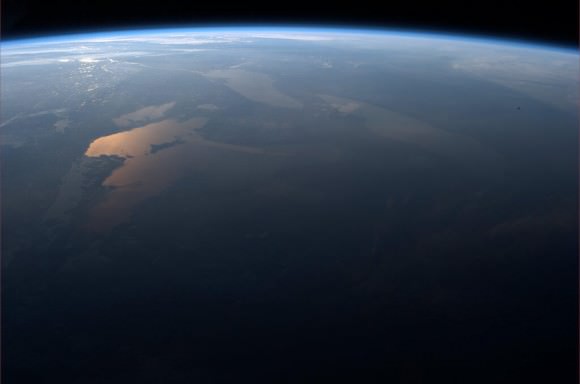
And the Canadian Space Agency has now passed along an Easter greeting card.
Astronaut and cosmonaut crews have a decade’s long tradition of celebrating religious holidays in space. Probably the most famous occasion was when the three man American crew of Apollo 8 read scriptures from Genesis marking the first time in history that humans were orbiting the Moon – back in 1968.
All in all it’s been a busy week aboard the massive orbiting lab complex.
On Tuesday, March 26, the SpaceX Dragon capsule departed the station, loaded with a long awaited trove of science goodies and successfully splashed down in the ocean. Two days later the trio of new space men arriving aboard the Soyuz restored the ISS to its full crew complement of six.
Since arriving at the station just before Christmas 2012, Hadfield has been doing a stellar job enlightening folks about what it’s like to live and work in space in fun and understandable ways.
Happy Easter !
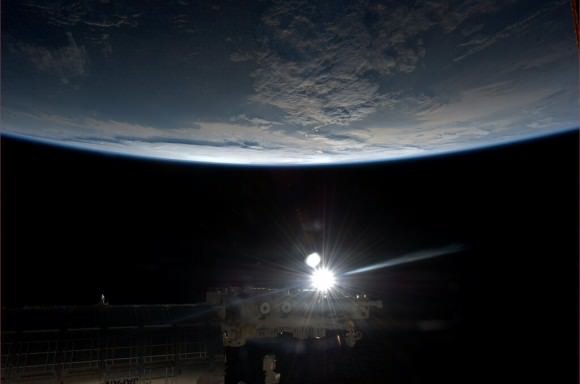
…………….
Learn more about the ISS, Curiosity, SpaceX, Antares, and NASA missions at Ken’s upcoming lecture presentations:
April 20/21 : “Curiosity and the Search for Life on Mars – (in 3-D)”. Plus Orion, SpaceX, Antares, ISS, the Space Shuttle and more! NEAF Astronomy Forum, Suffern, NY
April 28: “Curiosity and the Search for Life on Mars – (in 3-D)”. Plus the Space Shuttle, SpaceX, Antares, Orion and more. Washington Crossing State Park, Titusville, NJ, 130 PM
Soyuz Makes Record-Breaking ‘Fast Track’ to Space Station
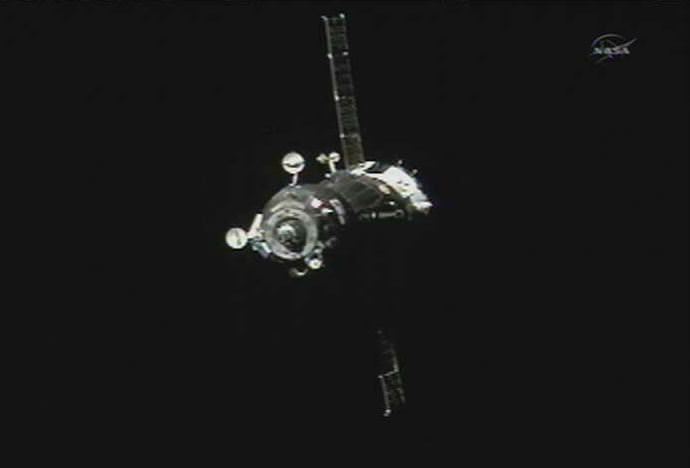
It was same day, freaky-fast delivery for the Soyuz TMA-08M spacecraft bringing the crew of Expedition 35/36 to the International Space Station. The expedited flight had the crew arriving even quicker than expected, in just 5 hours and 45 minutes after launch. The new abbreviated four-orbit rendezvous with the ISS uses a modified launch and docking profile for the Russian ships. It has been tried successfully with three Progress resupply vehicles, but this is the first time it has been used on a human flight.
In the past, Soyuz manned capsules and Progress supply ships were launched on trajectories that required about two days, or 34 orbits, to reach the ISS. The new fast-track trajectory has the rocket launching shortly after the ISS passes overhead. Then, additional firings of the vehicle’s thrusters early in its mission expedites the time required for a Russian vehicle to reach the Station.
Liftoff of the Soyuz TMA-08M spacecraft took place at 4:43 p.m. EDT (20:43 UTC) on March 28 from the Baikonur Cosmodrome in Kazakhstan, and Russian commander Pavel Vinogradov, cosmonaut Aleksandr Misurkin and NASA astronaut Chris Cassidy docked with the ISS’s Poisk module at 10:28 p.m. EDT on Thursday (March 28; 0228 GMT Friday).
Hatches will be opened shortly, and Expedition 35 commander Chris Hadfield,astronaut Tom Marshburn and cosmonaut Roman Romanenko will welcome their new crewmates aboard. Update: Here’s the video of the hatch opening:
Find out more about the “fast-track” trajectory in our earlier articles here and here.



